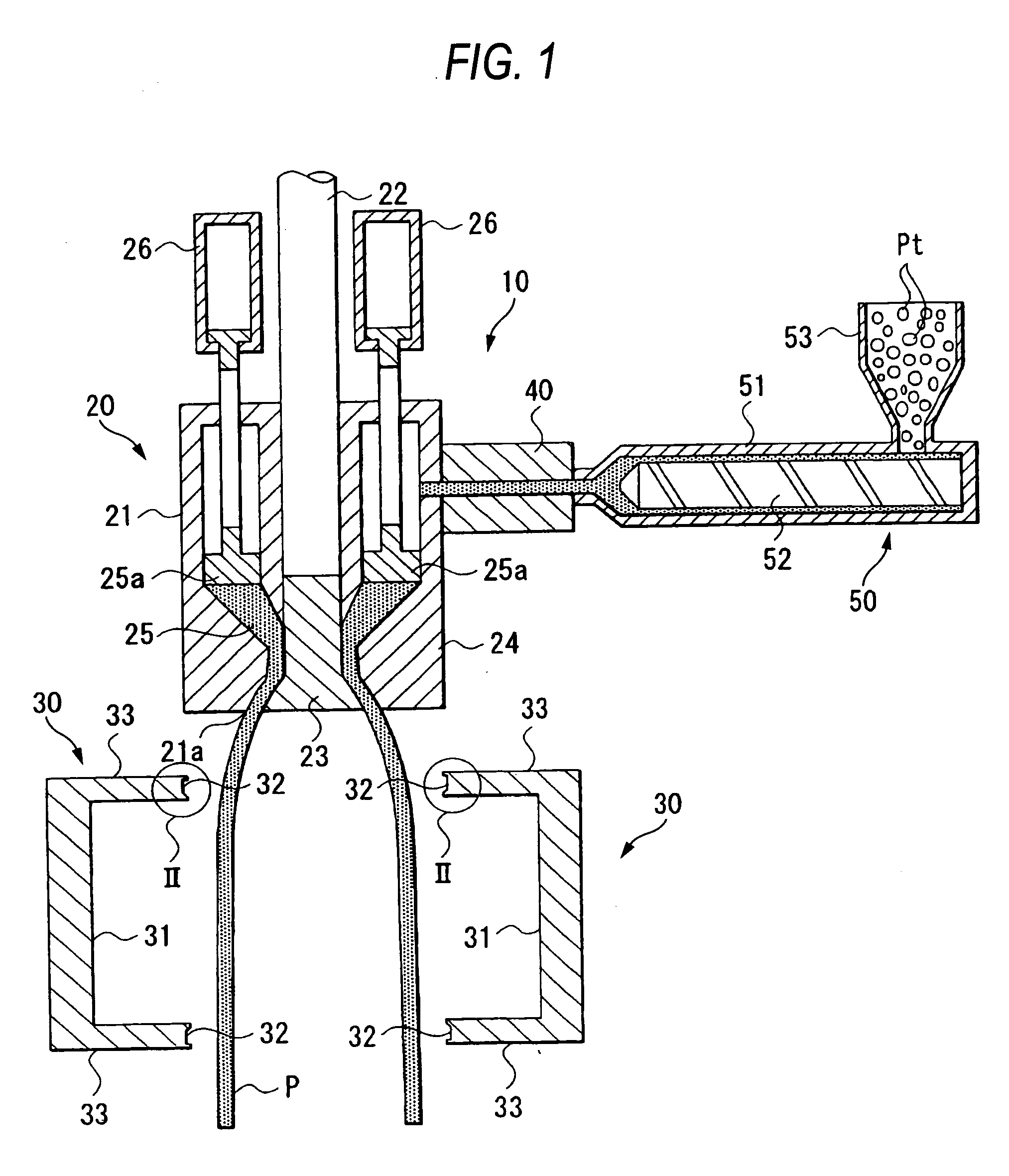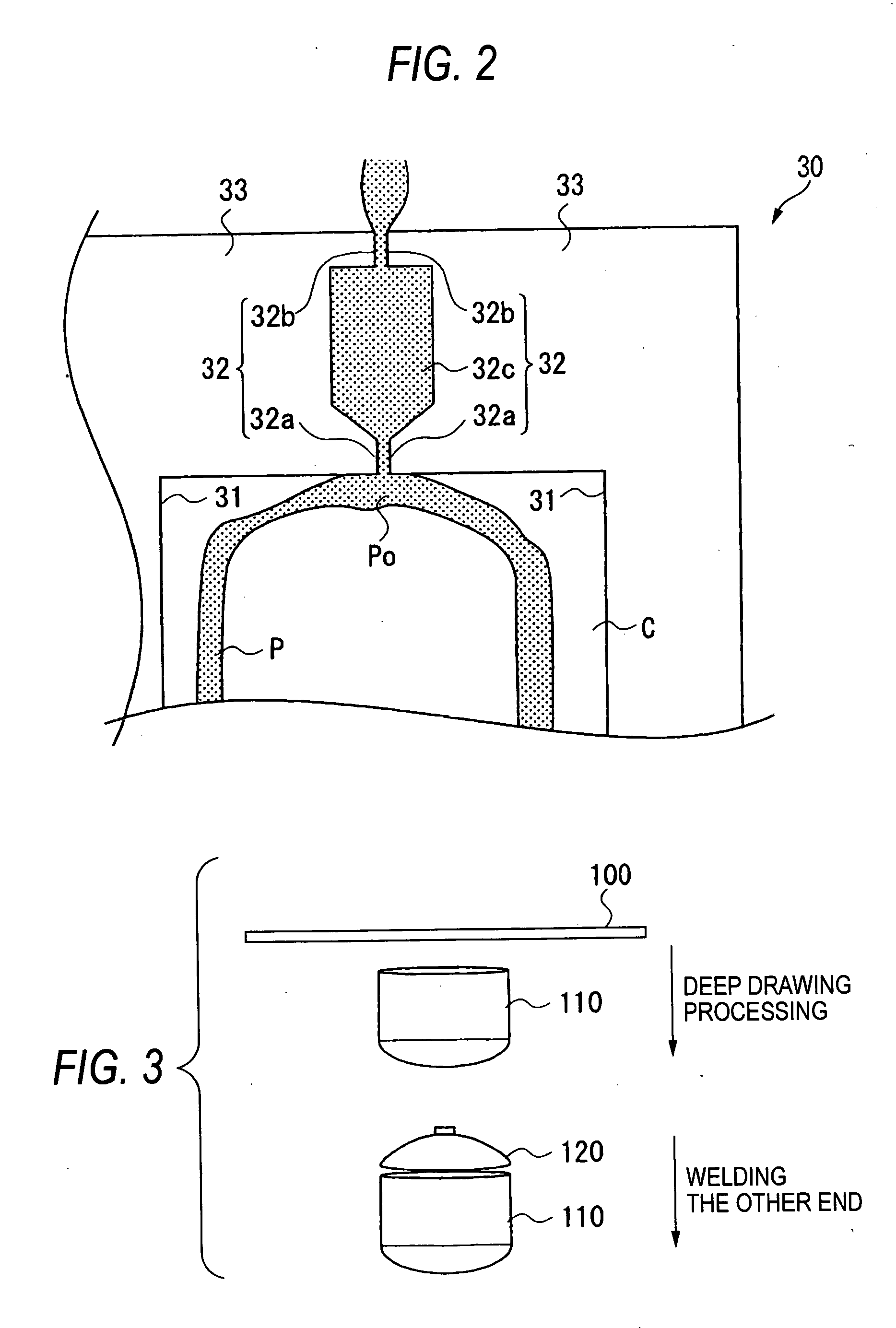Method for manufacturing liner for pressure resistant container and liner made of liquid crystal resin
a technology of liquid crystal resin and pressure resistant containers, which is applied in the direction of transportation and packaging, mechanical equipment, other domestic objects, etc., can solve the problems of inability to achieve large reduction in weight, difficulty in applying to fuel tanks for automobiles or aerospace vehicles, and reduced weight, so as to achieve favorable blow molding characteristics, improve the anisotropy of liquid crystal resin, and improve the strength of liquid crystal resin
- Summary
- Abstract
- Description
- Claims
- Application Information
AI Technical Summary
Benefits of technology
Problems solved by technology
Method used
Image
Examples
production example 1
Production of Polymer A
[0098] 345 parts by weight of P-hydroxybenzoic acid, 175 parts by weight of 6-hydroxy-2-naphthoic acid, 0.02 part by weight of potassium acetate, and 350 parts by weight of acetic anhydride were respectively charged in a reactor equipped with a stirrer and a distillation tube, and nitrogen replacement was sufficiently performed. Then, the temperature was raised to 150° C. under normal pressure to start stirring. Stirring was performed at 150° C. for 30 minutes, and the temperature was further raised gradually to distill away by-produced acetic acid. When the temperature reached 300° C., the pressure in the reactor was gradually reduced. Stirring was continued under a pressure of 5 torr for 1 hour. At the instant when an objective stirring torque was reached, the discharge port at the lower part of the reactor was opened, and the resin was taken out in the form of a strand by using the nitrogen pressure. The discharged strand was made into the form of pellets ...
production example 2
Production of Polymer B
[0099] 173 parts by weight of P-hydroxybenzoic acid, 38 parts by weight of 6-hydroxy-2-naphthoic acid, 52 parts by weight of 4,4′-dihydroxybiphenyl, 65 parts by weight of terephthalic acid, 17 parts by weight of 4-acetaminophenol, 0.04 parts by weight of potassium acetate, and 221 parts by weight of acetic anhydride were respectively charged in a reactor equipped with a stirrer and a distillation tube, and nitrogen replacement was sufficiently performed. Then, the temperature was raised to 150° C. under normal pressure to start stirring. Stirring was performed at 150° C. for 30 minutes, and the temperature was further raised gradually to distill away by-produced acetic acid. When the temperature reached 350° C., the pressure in the reactor was gradually reduced. Stirring was continued under a pressure of 5 torr for 1 hour. At the instant when an objective stirring torque was reached, the discharge port at the lower part of the reactor was opened, and the resi...
production example 3
Production of Polymer C
[0100] 285 parts by weight of P-hydroxybenzoic acid, 30 parts by weight of 6-hydroxy-2-naphthoic acid, 80 parts by weight of 4,4′-dihydroxybiphenyl, 25 parts by weight of 4-acetaminophenol, 100 parts by weight of terephthalic acid, 0.07 part by weight of potassium acetate, and 350 parts by weight of acetic anhydride were respectively charged in a reactor equipped with a stirrer and a distillation tube, and nitrogen replacement was sufficiently performed. Then, the temperature was raised to 150° C. under normal pressure to start stirring. Stirring was performed at 150° C. for 80 minutes, and the temperature was further raised gradually to distill away by-produced acetic acid. When the temperature reached 350° C., the pressure in the reactor was gradually reduced. Stirring was continued under a pressure of 5 torr for 1 hour. At the instant when an objective stirring torque was reached, the discharge port at the lower part of the reactor was opened, and the resi...
PUM
| Property | Measurement | Unit |
|---|---|---|
| melting point | aaaaa | aaaaa |
| temperature | aaaaa | aaaaa |
| melt viscosity | aaaaa | aaaaa |
Abstract
Description
Claims
Application Information
 Login to View More
Login to View More - R&D
- Intellectual Property
- Life Sciences
- Materials
- Tech Scout
- Unparalleled Data Quality
- Higher Quality Content
- 60% Fewer Hallucinations
Browse by: Latest US Patents, China's latest patents, Technical Efficacy Thesaurus, Application Domain, Technology Topic, Popular Technical Reports.
© 2025 PatSnap. All rights reserved.Legal|Privacy policy|Modern Slavery Act Transparency Statement|Sitemap|About US| Contact US: help@patsnap.com



